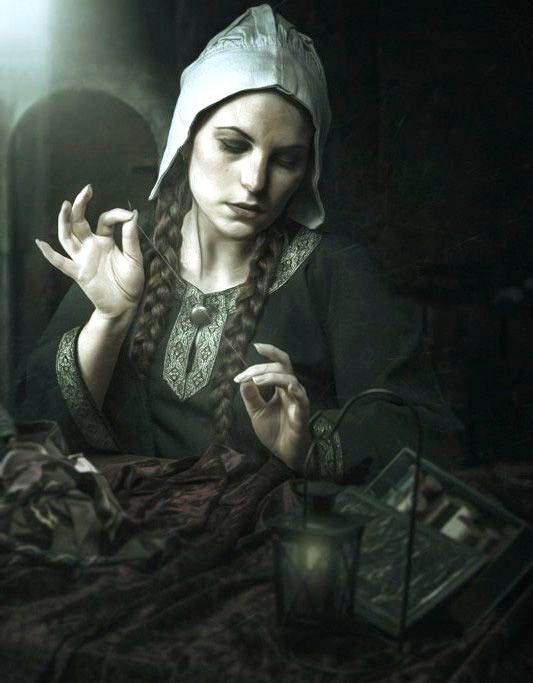Difference between revisions of "Stitch (cantrip)"
Tao alexis (talk | contribs) |
Tao alexis (talk | contribs) |
||
| Line 1: | Line 1: | ||
[[File:Stitch (cantrip).jpg|right|490px|thumb]] | [[File:Stitch (cantrip).jpg|right|490px|thumb]] | ||
| − | '''Stitch''' restores cloth, fibrous material and the threading between leather pieces | + | '''Stitch''' is a [[Cantrip|cantrip]] that restores and seamlessly resews cloth, fibrous material and the threading between leather pieces, returning them to a functional state. It repairs damage by reweaving fibers and tightening seams, making frayed or torn objects whole again. However, the cantrip cannot create material from raw fibers — it can only work with pieces that have already been crafted through weaving, spinning or other manual methods. |
{{Spelltable | {{Spelltable | ||
| Line 9: | Line 9: | ||
| casting time = 2 [[Action Points|action points]] | | casting time = 2 [[Action Points|action points]] | ||
| save = none | | save = none | ||
| − | | level = | + | | level = cantrip |
}} | }} | ||
| + | The effect extends to a variety of fibrous substances, including thread, twine, string and heavier materials like hemp, ramie and burlap. If a piece of fabric or rope has been completely severed, the cantrip can rejoin the parts as though they had never been separated. Objects torn into multiple fragments can be gradually restored over successive castings, provided all the original pieces remain available. | ||
| − | + | Beyond simple mending, stitch can also join separate textiles together, permanently fusing them into a single piece. A patch can be affixed to a cloak, a skirt merged with a bodice or two ropes woven into one continuous length without knots or seams. | |
| − | + | Because the cantrip can only manipulate existing fabric and thread, it does not serve as a substitute for tailoring or weaving. However, in the hands of a skilled tailor, stitch can be a valuable tool for handling the most delicate or tedious aspects of garment construction. If fabric pieces have been pre-cut for a pattern, the cantrip can bind them together with magical precision, leaving only finishing work to be done. While a tailor working by hand would be far faster than waiting for the cantrip to become available each day, stitch allows for near-perfect seams and reinforced stitching, creating a garment of exceptional quality when used with care and expertise. | |
| − | See [[Useful Cantrips]] | + | See also,<br> |
| + | [[Unravel (cantrip)|Unravel]]<br> | ||
| + | [[Useful Cantrips]] | ||
| − | [[Category: Cantrips]] | + | [[Category: Cantrips]][[Category: Reviewed]] |
Revision as of 23:44, 5 February 2025
Stitch is a cantrip that restores and seamlessly resews cloth, fibrous material and the threading between leather pieces, returning them to a functional state. It repairs damage by reweaving fibers and tightening seams, making frayed or torn objects whole again. However, the cantrip cannot create material from raw fibers — it can only work with pieces that have already been crafted through weaving, spinning or other manual methods.
| Range | 10 ft. |
| Duration | permanent |
| Area of Effect | up to 2 objects |
| Casting Time | 2 action points |
| Saving Throw | none |
| Level | cantrip |
The effect extends to a variety of fibrous substances, including thread, twine, string and heavier materials like hemp, ramie and burlap. If a piece of fabric or rope has been completely severed, the cantrip can rejoin the parts as though they had never been separated. Objects torn into multiple fragments can be gradually restored over successive castings, provided all the original pieces remain available.
Beyond simple mending, stitch can also join separate textiles together, permanently fusing them into a single piece. A patch can be affixed to a cloak, a skirt merged with a bodice or two ropes woven into one continuous length without knots or seams.
Because the cantrip can only manipulate existing fabric and thread, it does not serve as a substitute for tailoring or weaving. However, in the hands of a skilled tailor, stitch can be a valuable tool for handling the most delicate or tedious aspects of garment construction. If fabric pieces have been pre-cut for a pattern, the cantrip can bind them together with magical precision, leaving only finishing work to be done. While a tailor working by hand would be far faster than waiting for the cantrip to become available each day, stitch allows for near-perfect seams and reinforced stitching, creating a garment of exceptional quality when used with care and expertise.
See also,
Unravel
Useful Cantrips
